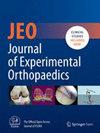Three-dimensional reconstruction of the knee joint based on automated 1.5T magnetic resonance image segmentation: A feasibility study
Abstract
Purpose
To validate the accuracy of three-dimensional (3D) bone and cartilage reconstructions of the distal femur and proximal tibia derived from 1.5 Tesla magnetic resonance imaging (MRI), using fully automated and semi-automated segmentation methods, compared to surface laser scanning (LS) as the reference standard.
Methods
Eleven fresh-frozen cadaveric knees were imaged using a 1.5 T MRI scanner. Manual (MS), fully automated (A), and semi-automated (SA) segmentations were performed to generate 3D models of the distal femur and proximal tibia. A transformer-based deep learning model (UNet-R) was used for automated segmentation. Laser surface scanning provided high-resolution ground-truth 3D models. Point-to-surface distances between MRI-based and LS-derived models were calculated to assess reconstruction accuracy. Bland-Altman analyses were performed to compare segmentation methods. Time to generate 3D models was recorded for each method.
Results
The mean absolute point-to-surface distance for femoral models was 1.19 mm (±0.42) for MRI A, 1.05 mm (±0.09) for MRI SA, and 0.99 mm (±0.08) for MRI MS. For tibial models, the corresponding values were 1.54 mm (±1.02), 1.03 mm (±0.17), and 0.93 mm (±0.14), respectively. MRI A showed larger variability, which required manual correction. Time analysis revealed significant efficiency gains: 27 s for MRI A, 1520 s for MRI SA, and 14,191 s for MRI MS (p < 0.001). Bland-Altman plots confirmed improved agreement of MRI SA with MRI MS.
Conclusions
MRI-based 3D reconstructions of the knee using a 1.5 T system and semi-automated segmentation achieved sub-millimetre accuracy comparable to manual segmentation and significantly outperformed fully automated models in precision, while substantially reducing segmentation time. These findings support the integration of AI-assisted 3D reconstruction into preoperative planning workflows for knee ligament surgery, offering a reliable, radiation-free alternative to CT-based modelling.
Level of Evidence
Level IV, controlled laboratory study.

 求助内容:
求助内容: 应助结果提醒方式:
应助结果提醒方式:


